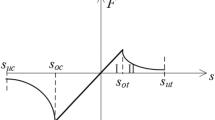Abstract
In this paper, a peridynamic model for simulating the dynamic fracture in layered engineered cementitious composites (LECC) is applied. The model takes into account the location information of the fibers as well as the distribution form. In addition, numerical simulations of LECC beams under four-point bending are carried out. The effects of notch size and fiber volume fraction are investigated. The numerical results show that the notch size and gradient distribution of fiber volume fraction affect the crack propagation pattern, which can help to understand the dynamic fracture behavior of engineered cementitious composites.







Similar content being viewed by others
References
Koizumi M. FGM activities in Japan. Compos Part B Eng. 1997;28(1–2):1–4.
Guo QG. Functionally graded materials. New Carbon Mater. 2003;18(2):158–9.
Cheng ZQ, Zhang GF, Wang YN, Bobaru F. A peridynamic model for dynamic fracture in functionally graded materials. Compos Struct. 2015;133:529–46.
Zhang P, Zhu Q, Qin HY, et al. Research progress of high temperature materials for aero-engines. Mater Rev. 2014;11:27–31.
Bobaru F. Designing Optimal Volume Fractions For Functionally Graded Materials With Temperature-Dependent Material Properties. J Appl Mech. 2007;74(4):861–74.
Liu BF, Liu YY, Zhou R. Innovative material design and mechanical properties study of variable geometry chevron for aeroengine. Mater Rep. 2020;34(2):2117–22.
Chen ZL, Jin K, Liu SY, et al. FGM’s preparations and application for mechanical engineering. Heat Treat Met. 2002;3:5–8.
Shen QQ, Pan YS. Preparation technology and performance evaluation for bio-functionally graded material. Hot Work Technol. 2015;44(14):21–4.
Li VC, Leung CKY. Steady-state and multiple cracking of short random fiber composites. J Eng Mech. 1992;118(11):2246–64.
Li VC. On engineered cementitious composites (ECC): A review of the material and its applications. J Adv Concr Technol. 2003;1(3):215–30.
Li VC, Wang S, Wu C. Tensile strain-hardening behavior of polyvinyl alcohol engineered cementitious composite (PVA-ECC). ACI Mater J. 2001;98(6):483–92.
Yang YF, Tang CA, Xia KW. Study on crack curving and branching mechanism in quasi-brittle materials under dynamic biaxial loading. Int J Fracture. 2012;177(1):53–72.
Jiang Y, Dong J, Nie DF, et al. XFEM with partial Heaviside function enrichment for fracture analysis. Eng Fract Mech 2020; 107375.
Murotani K, Yagawa G, Choi JB. Adaptive finite elements using hierarchical mesh and its application to crack propagation analysis. Comput Method Appl M. 2013;253:1–14.
Marder M, Gross S. Origin of crack tip instabilities. J Mech Phys Solids. 1995;43(1):1–48.
Zhou SJ, Lomdahl PS, Thomson R, Holian BL. Dynamic crack processes via molecular dynamics. Phys Rev Lett. 1996;76(13):2318–21.
Camacho GT, Ortiz M. Computational modeling of impact damage in brittle materials. Int J Solids Struct. 1996;33(20):2899–938.
Silling SA. Reformulation of elasticity theory for discontinuities and long-range forces. J Mech Phys Solids. 2000;48(1):175–209.
Silling SA, Askari E. A meshfree method based on the peridynamic model of solid mechanics. Comput Struct. 2005;83(14):1526–35.
Silling SA, Lehoucq RB. Peridynamic theory of solid mechanics. Adv Appl Mech. 2010;44:73–168.
Askari E, Xu J, Silling SA. Peridynamic analysis of damage and failure in composites. 44th AIAA Aerospace Sciences Meeting and Exhibit 2006.
Kilic B, Agwai A, Madenci E. Peridynamic Theory for progressive damage prediction in center-cracked composite laminates. Compos Struct. 2009;90(2):141–51.
Hu W, Ha YD, Bobaru F. Modeling dynamic fracture and damage in a fiber-reinforced composite lamina with peridynamics. Int J Multiscale Com. 2011;9(6):707–26.
Hu W, Ha YD, Bobaru F. Peridynamic model for dynamic fracture in unidirectional fiber-reinforced composites. Comput Method Appl M 2012:247-61.
Oterkus E, Madenci E. Peridynamic Theory for damage initiation and growth in composite laminate. Key Eng Mater. 2012;488–489:355–8.
Oterkus E, Madenci E. Peridynamic analysis of fiber-reinforced composite materials. J Mech Mater Struct. 2012;7(1):45–84.
Bobaru F, Yang MJ, Leonardo FA, Silling SA. Convergence, adaptive refinement, and scaling in 1D peridynamics. Int J Numer Methods Eng 2009; 77(6).
Bobaru F, Zhang GF. Why do cracks branch? A peridynamic investigation of dynamic brittle fracture. Int J Fract. 2015;196:59–98.
Ha YD, Bobaru F. Characteristics of dynamic brittle fracture captured with peridynamics. Eng Fract Mech. 2011;78(5):1156–68.
Ha YD, Bobaru F. Studies of dynamic crack propagation and crack branching with peridynamics. Int J Fract. 2015;162(1):229–44.
Cheng ZQ, Sui ZB, Yin H, Feng H. Numerical simulation of dynamic fracture in functionally graded materials using peridynamic modeling with composite weighted bonds. Eng Anal Bound Elem. 2019;105:36–41.
Cheng ZQ, Liu YK, Zhao J, Feng H, Wu YZ. Numerical simulation of crack propagation and branching in functionally graded materials using peridynamic modeling. Eng Fract Mech. 2018;191:13–32.
Radtke F, Simone A, Sluys L. A computational model for failure analysis of fiber reinforced concrete with discrete treatment of fibers. Eng Fract Mech. 2010;77(3):597–620.
Lin Z, Kanda T, Li VC. On interface property characterization and performance of fiber reinforced cementitious composites. J Concrete Sci Eng. 1999;1(3):173–84.
Kang J, Kim K, Lim YM. Modeling of fiber-reinforced cement composites: discrete representation of fiber pullout. Int J Solids Struct. 2014;51(10):1970–9.
Acknowledgements
This work is supported by the National Natural Science Foundation of China (Nos. 11872339, 11472248) and the Natural Science Foundation of Henan Province (No. 182300410221).
Author information
Authors and Affiliations
Corresponding author
Ethics declarations
Declaration of Competing Interest
The authors declare that they have no known competing financial interests or personal relationships that could have appeared to influence the work reported in this paper.
Rights and permissions
About this article
Cite this article
Wu, Y., Zhou, J., Tang, J. et al. A Peridynamic Model for Dynamic Fracture of Layered Engineered Cementitious Composites. Acta Mech. Solida Sin. 35, 661–671 (2022). https://doi.org/10.1007/s10338-022-00312-9
Received:
Revised:
Accepted:
Published:
Issue Date:
DOI: https://doi.org/10.1007/s10338-022-00312-9




